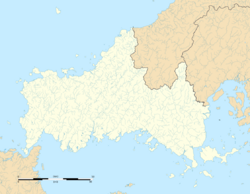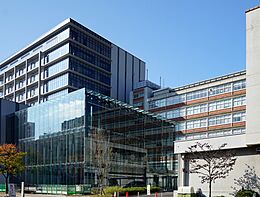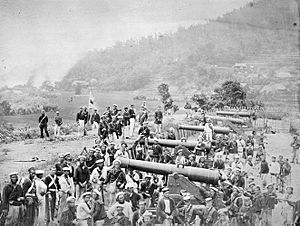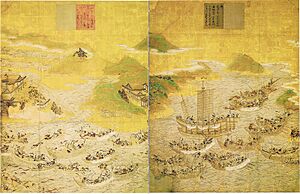Shimonoseki facts for kids
Quick facts for kids
Shimonoseki
下関市
|
|||||||||||||||||
|---|---|---|---|---|---|---|---|---|---|---|---|---|---|---|---|---|---|
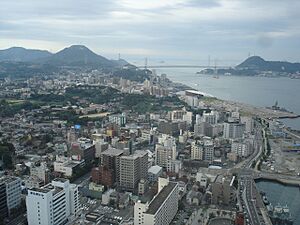
Central Shimonoseki and Kanmon Strait
|
|||||||||||||||||
|
|||||||||||||||||
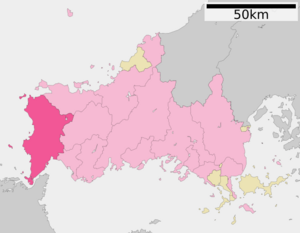 |
|||||||||||||||||
| Country | Japan | ||||||||||||||||
| Region | Chūgoku (San'yō) | ||||||||||||||||
| Prefecture | Yamaguchi | ||||||||||||||||
| As Akamagaseki | April 1, 1889 | ||||||||||||||||
| As Shimonoseki | June 1, 1902 | ||||||||||||||||
| Area | |||||||||||||||||
| • Total | 716.18 km2 (276.52 sq mi) | ||||||||||||||||
| Population
(June 30, 2023)
|
|||||||||||||||||
| • Total | 248,193 | ||||||||||||||||
| • Density | 346.5511/km2 (897.563/sq mi) | ||||||||||||||||
| Time zone | UTC+09:00 (JST) | ||||||||||||||||
| City hall address | 1-1 Nanbu, Shimonoseki-shi, Yamaguchi-ken 750-8521 |
||||||||||||||||
| Climate | Cfa | ||||||||||||||||
|
|||||||||||||||||
Shimonoseki (Japanese: 下関市, Hepburn: Shimonoseki-shi) is a city located in Yamaguchi Prefecture, Japan. As of June 2023, about 248,193 people live there. The city covers an area of 716.18 square kilometers (276.52 sq mi).
Shimonoseki is the largest city in Yamaguchi Prefecture. It is also the fifth-largest city in the Chūgoku region by population. The city is often called the "Fugu Capital." This is because many pufferfish are caught here. Shimonoseki is the biggest place in Japan for catching this special fish.
Contents
Shimonoseki's Story: A Journey Through Time
Shimonoseki has been an important place for a very long time. It was a key gateway to Honshu island from other parts of Asia. This includes places like Kyushu, China, and Korea.
Early Days and Important Battles
Ancient records say that an emperor built a palace here long ago. The city's name, "Shimonoseki," appeared in documents from 869 AD. It was a checkpoint for ships entering the Seto Inland Sea. Later, it was also known as "Akamanoseki."
During the Genpei War, a big battle happened near here in 1185. It was called the Battle of Dan-no-ura. Two powerful clans, the Heike and Genji, fought this battle.
Trade, Explorers, and Major Events
In the Muromachi period, a strong family called the Ōuchi clan controlled this area. They managed trade and visits from China and Korea. Later, in the Edo period, the Mōri clan ruled.
In 1691, a German explorer visited Shimonoseki. He described it as a major port. It supplied many ships in the region.
Later, in 1864, the city faced a big event called the Bombardment of Shimonoseki. In 1895, a very important agreement was signed here. It was the Treaty of Shimonoseki. This treaty ended the First Sino-Japanese War. After this, Shimonoseki became an open port for trade with the United States and the United Kingdom.
Modern Shimonoseki: Growth and Changes
The city of Akamagaseki was officially formed on April 1, 1889. It was renamed Shimonoseki on June 1, 1902.
In 2005, Shimonoseki grew bigger. It joined with several nearby towns. Since October 2005, Shimonoseki has been a "core city." This means it has more local control over its own affairs.
Where is Shimonoseki?
Shimonoseki is at the very western tip of Yamaguchi Prefecture. It's also the westernmost point of Honshu, Japan's main island.
Waterways and Neighbors
The city is surrounded by water. To the west is the Sea of Japan. To the south is the Seto Inland Sea, across the Kanmon Straits. The city stretches long from north to south.
Two rivers flow through Shimonoseki. The Asa River flows in the north and central areas. The Ariho River flows from the northeast to the east. Both rivers empty into the Seto Inland Sea.
Nearby Cities and Towns
Shimonoseki shares borders with other places in Yamaguchi Prefecture:
- Mine
- Nagato
- San'yō-Onoda
Shimonoseki's Weather
Shimonoseki has a humid subtropical climate. This means it has hot summers and cool winters. It rains quite a lot throughout the year, especially in summer.
| Climate data for Shimonoseki (1991−2020 normals, extremes 1883−present) | |||||||||||||
|---|---|---|---|---|---|---|---|---|---|---|---|---|---|
| Month | Jan | Feb | Mar | Apr | May | Jun | Jul | Aug | Sep | Oct | Nov | Dec | Year |
| Record high °C (°F) | 19.1 (66.4) |
23.7 (74.7) |
26.2 (79.2) |
29.7 (85.5) |
30.9 (87.6) |
33.7 (92.7) |
36.2 (97.2) |
37.0 (98.6) |
35.0 (95.0) |
30.6 (87.1) |
26.9 (80.4) |
26.2 (79.2) |
37.0 (98.6) |
| Mean daily maximum °C (°F) | 9.7 (49.5) |
10.5 (50.9) |
13.7 (56.7) |
18.4 (65.1) |
22.7 (72.9) |
25.8 (78.4) |
29.7 (85.5) |
31.3 (88.3) |
27.8 (82.0) |
23.0 (73.4) |
17.5 (63.5) |
12.3 (54.1) |
20.2 (68.4) |
| Daily mean °C (°F) | 7.2 (45.0) |
7.5 (45.5) |
10.3 (50.5) |
14.7 (58.5) |
19.1 (66.4) |
22.5 (72.5) |
26.5 (79.7) |
27.9 (82.2) |
24.6 (76.3) |
19.7 (67.5) |
14.5 (58.1) |
9.5 (49.1) |
17.0 (62.6) |
| Mean daily minimum °C (°F) | 4.8 (40.6) |
4.9 (40.8) |
7.4 (45.3) |
11.6 (52.9) |
16.2 (61.2) |
20.1 (68.2) |
24.2 (75.6) |
25.6 (78.1) |
22.2 (72.0) |
16.9 (62.4) |
11.8 (53.2) |
7.0 (44.6) |
14.4 (57.9) |
| Record low °C (°F) | −6.3 (20.7) |
−6.5 (20.3) |
−5.5 (22.1) |
0.5 (32.9) |
6.5 (43.7) |
9.5 (49.1) |
15.1 (59.2) |
17.5 (63.5) |
12.8 (55.0) |
5.9 (42.6) |
0.7 (33.3) |
−4.6 (23.7) |
−6.5 (20.3) |
| Average precipitation mm (inches) | 80.0 (3.15) |
75.9 (2.99) |
121.2 (4.77) |
130.8 (5.15) |
154.2 (6.07) |
253.6 (9.98) |
309.4 (12.18) |
190.0 (7.48) |
162.6 (6.40) |
83.7 (3.30) |
81.9 (3.22) |
69.1 (2.72) |
1,712.3 (67.41) |
| Average snowfall cm (inches) | 1 (0.4) |
1 (0.4) |
0 (0) |
0 (0) |
0 (0) |
0 (0) |
0 (0) |
0 (0) |
0 (0) |
0 (0) |
0 (0) |
0 (0) |
2 (0.8) |
| Average precipitation days (≥ 1.0 mm) | 9.3 | 9.1 | 10.1 | 9.6 | 8.7 | 11.3 | 10.7 | 9.1 | 8.5 | 6.1 | 8.0 | 9.0 | 109.5 |
| Average snowy days (≥ 1 cm) | 0.4 | 0.6 | 0 | 0 | 0 | 0 | 0 | 0 | 0 | 0 | 0 | 0 | 1 |
| Average relative humidity (%) | 63 | 63 | 65 | 67 | 70 | 78 | 79 | 75 | 73 | 67 | 66 | 63 | 69 |
| Mean monthly sunshine hours | 95.8 | 116.1 | 162.9 | 187.6 | 207.1 | 146.6 | 172.4 | 207.2 | 161.9 | 176.3 | 134.7 | 102.6 | 1,875.9 |
| Source: Japan Meteorological Agency | |||||||||||||
| Climate data for Toyota, Shimonoseki (1991−2020 normals, extremes 1977−present) | |||||||||||||
|---|---|---|---|---|---|---|---|---|---|---|---|---|---|
| Month | Jan | Feb | Mar | Apr | May | Jun | Jul | Aug | Sep | Oct | Nov | Dec | Year |
| Record high °C (°F) | 16.7 (62.1) |
21.8 (71.2) |
25.1 (77.2) |
28.4 (83.1) |
31.4 (88.5) |
32.2 (90.0) |
35.7 (96.3) |
36.2 (97.2) |
35.0 (95.0) |
30.7 (87.3) |
26.0 (78.8) |
23.2 (73.8) |
36.2 (97.2) |
| Mean daily maximum °C (°F) | 8.7 (47.7) |
9.8 (49.6) |
13.4 (56.1) |
18.6 (65.5) |
23.1 (73.6) |
25.9 (78.6) |
29.3 (84.7) |
30.7 (87.3) |
27.2 (81.0) |
22.3 (72.1) |
16.7 (62.1) |
11.2 (52.2) |
19.7 (67.5) |
| Daily mean °C (°F) | 3.6 (38.5) |
4.4 (39.9) |
7.5 (45.5) |
12.4 (54.3) |
17.3 (63.1) |
21.2 (70.2) |
25.1 (77.2) |
25.9 (78.6) |
22.0 (71.6) |
16.1 (61.0) |
10.4 (50.7) |
5.4 (41.7) |
14.3 (57.7) |
| Mean daily minimum °C (°F) | −1.1 (30.0) |
−0.8 (30.6) |
1.7 (35.1) |
6.1 (43.0) |
11.4 (52.5) |
17.0 (62.6) |
21.6 (70.9) |
22.1 (71.8) |
17.8 (64.0) |
10.8 (51.4) |
5.0 (41.0) |
0.5 (32.9) |
9.3 (48.8) |
| Record low °C (°F) | −7.9 (17.8) |
−9.1 (15.6) |
−6.2 (20.8) |
−4.0 (24.8) |
0.0 (32.0) |
5.5 (41.9) |
12.0 (53.6) |
14.3 (57.7) |
4.6 (40.3) |
−0.6 (30.9) |
−3.7 (25.3) |
−6.3 (20.7) |
−9.1 (15.6) |
| Average precipitation mm (inches) | 90.8 (3.57) |
88.3 (3.48) |
140.5 (5.53) |
151.4 (5.96) |
183.7 (7.23) |
272.5 (10.73) |
342.8 (13.50) |
201.2 (7.92) |
167.8 (6.61) |
93.3 (3.67) |
88.2 (3.47) |
83.1 (3.27) |
1,899.1 (74.77) |
| Average precipitation days (≥ 1.0 mm) | 11.3 | 10.7 | 11.6 | 10.0 | 9.5 | 12.4 | 11.6 | 9.9 | 9.5 | 7.7 | 9.3 | 11.1 | 124.6 |
| Mean monthly sunshine hours | 99.8 | 107.6 | 156.1 | 182.9 | 206.1 | 137.0 | 152.6 | 189.8 | 151.6 | 169.5 | 134.5 | 103.9 | 1,791.3 |
| Source: Japan Meteorological Agency | |||||||||||||
People of Shimonoseki
Shimonoseki has been counting its population since 1920. In 2020, the city had 255,051 people.
| Historical population | ||
|---|---|---|
| Year | Pop. | ±% |
| 1920 | 192,840 | — |
| 1925 | 213,109 | +10.5% |
| 1930 | 222,702 | +4.5% |
| 1935 | 237,248 | +6.5% |
| 1940 | 261,549 | +10.2% |
| 1945 | 261,982 | +0.2% |
| 1950 | 280,949 | +7.2% |
| 1955 | 308,799 | +9.9% |
| 1960 | 317,029 | +2.7% |
| 1965 | 317,146 | +0.0% |
| 1970 | 315,603 | −0.5% |
| 1975 | 322,300 | +2.1% |
| 1980 | 325,478 | +1.0% |
| 1985 | 324,585 | −0.3% |
| 1990 | 315,643 | −2.8% |
| 1995 | 310,717 | −1.6% |
| 2000 | 301,097 | −3.1% |
| 2005 | 290,693 | −3.5% |
| 2010 | 280,987 | −3.3% |
| 2015 | 268,517 | −4.4% |
| 2020 | 255,051 | −5.0% |
| Shimonoseki population statistics | ||
Shimonoseki's Economy
Because Shimonoseki is a port city, it has a strong economy. Industries like shipping, trade, and finance have always been important. Today, it remains a key economic hub in the prefecture.
Learning in Shimonoseki
Shimonoseki offers many educational opportunities.
Universities and Colleges
- Baiko Gakuin University
- Baiko Gakuin University Women's Junior College
- National Fisheries University
- Shimonoseki City University
- Shimonoseki Junior College
- University of East Asia
Schools for Younger Students
The city government runs 41 public elementary schools. It also operates 21 public junior high schools and one public high school. The Yamaguchi Prefectural Board of Education manages nine more public high schools. There are also private schools and special education schools for students with disabilities.
Getting Around Shimonoseki
Train Travel
You can travel by train in Shimonoseki using the JR West lines.
 JR West – San'yō Shinkansen
JR West – San'yō Shinkansen
- Shin-Shimonoseki
 JR West - San'yō Main Line
JR West - San'yō Main Line
- Ozuki - Chōfu - Shin-Shimonoseki - Hatabu - Shimonoseki
 JR West - San'in Main Line
JR West - San'in Main Line
- Nagato-Awano - Agawa - Kottoi - Takibe - Nagato-Futami - Ukahongō - Yutama - Kogushi - Kawatana-Onsen - Kuroimura - Umegatō - Yoshimi - Fukue - Yasuoka - Kajikuri-Gōdaichi - Ayaragi - Hatabu - Shimonoseki
Major Roads
 Chugoku Expressway
Chugoku Expressway National Route 2
National Route 2 National Route 9
National Route 9 National Route 191
National Route 191 National Route 435
National Route 435 National Route 491
National Route 491
Ferry Services
From Shimonoseki Port International Terminal, you can take ferries to other countries:
- The Kanpu ferry travels to Busan, South Korea.
- The Gwangyang Beech travels to Gwangyang, South Korea.
- The Orient ferry travels to Shanghai, China.
Shimonoseki's Sister Cities
Shimonoseki has special connections with cities around the world. These are called sister cities.
Fun Things to Do in Shimonoseki
Shimonoseki has many interesting places to visit and fun festivals.
Festivals and Events
Many festivals happen throughout the year. The most famous are the Shimonoseki Kaikyo Festival and Shimonoseki Bakan Festival.
- Shimonoseki Fugu Festival (February): Held at Haedomari Market.
- Kawatana Onsen Festival (April)
- Shimonoseki Kaikyo Festival (May): Takes place at Karato and Ganryujima Island.
- Suhouteisai Festival (August): Celebrated in the castle town of Chofu.
- Kanmon Kaikyo Fireworks Festival (August): Enjoy fireworks at Karato (Aruka Port area).
- Shimonoseki Bakan Festival (August): A street festival from Karato-cho to Shimonoseki Station.
- TOUR de Shimonoseki (October/November)
- Shimonoseki Kaikyo Marathon (November)
- Shimonoseki Fish Festival (November): At Shimonoseki Fishing Port.
- Little Busan Fest (November): Held at Green Mall.
Cool Buildings and Temples
- Akama Shrine
- Kaikyō Yume Tower
- Kōzan-ji - This temple has a special building called a butsuden. It was finished in 1320 and is a National Treasure of Japan.
Museums to Explore
- Doigahama Site Anthropological Museum
- The Firefly Museum of Toyota Town
- Shimonoseki City Archaeological Museum
- Shimonoseki City Art Museum
- Shimonoseki City Museum of History
- Shimonoseki Marine Science Museum (Shimonoseki City Aquarium) (Kaikyo Kan)
- The Yamagin Archive (やまぎん史料館) of the Yamaguchi Bank
Parks and Monuments
- The Mimosusogawa Park (みもすそ川公園) in Shimonoseki is a park that remembers the end of the Genpei war. This was a big war between two powerful clans long ago. The park has a historical monument with cannons.
Sports and Venues
Professional Teams
- FC Baleine Shimonoseki (plays football)
Sports Stadiums and Pools
- Nogihama General Park (a football stadium)
- Shimonoseki Baseball Stadium
- Shimonoseki Boat Race Stadium (Shimonoseki Kyōtei)
- Shimonoseki City Gymnasium
- Shimonoseki city swimming pool
- Shimonoseki Track and field stadium
Famous People from Shimonoseki
- Arata Izumi (an Indian football player)
- Yūsaku Matsuda (an actor)
- Toshihiro Nagoshi (a video game director and producer)
- Atsushi Tamura (a comedian, actor, and singer)
- Kinuyo Tanaka (an actress)
See also
 In Spanish: Shimonoseki para niños
In Spanish: Shimonoseki para niños




